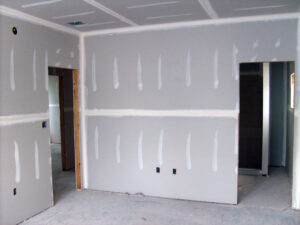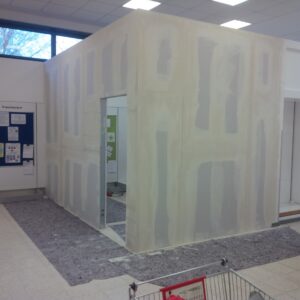Drywall is one of the most common building materials in residential and commercial construction. It’s versatile, cost-effective, and relatively easy to install, making it the go-to choice for many projects. However, while drywall has a lot going for it, there are situations where alternative materials may be better suited. Understanding when and when not to use drywall can save time, money, and ensure a high-quality finish. Here’s a guide to help you make an informed decision.

When to Use Drywall
- Interior Walls in Dry Areas
- Drywall excels in interior spaces like bedrooms, living rooms, and hallways. It’s a cost-effective material for creating smooth, even surfaces ideal for painting and wallpapering. Since these areas are typically dry, standard drywall offers excellent durability without extra protection.
- Quick and Cost-Effective Finishes
- Drywall is generally easy to install, and it’s a budget-friendly option compared to other wall materials like plaster or wood paneling. For projects with tight deadlines or limited budgets, drywall can be a practical solution, providing a high-quality finish at a low cost.
- Soundproofing
- When paired with insulation, certain types of drywall can provide decent soundproofing, making it a good option for bedrooms, home offices, or media rooms. Sound-dampening drywall, known as acoustic or soundproof drywall, is specifically designed to reduce noise transmission between rooms.
- Fire Resistance
- Specialized drywall, like Type X drywall, has fire-resistant properties, making it ideal for fire-rated walls or areas that require additional fire safety measures. It’s commonly used in garages, utility rooms, and walls separating living spaces from garages.
- Mold and Moisture Resistance (with Specialized Drywall)
- While standard drywall isn’t suitable for moisture-prone areas, green board and purple board are types of drywall designed to resist moisture and mold. They’re excellent for use in bathrooms or kitchens where moisture exposure is higher but shouldn’t be directly exposed to water.
When Not to Use Drywall
- Exterior Walls and Outdoor Spaces
- Drywall is not suitable for outdoor use. It’s highly susceptible to moisture damage and deteriorates quickly when exposed to weather conditions. Exterior walls should use weather-resistant materials like brick, siding, or cement board to withstand the elements.
- High-Moisture or Wet Areas
- Even mold- and moisture-resistant drywall isn’t intended for use in constantly wet areas like showers or around sinks. Tile backer boards, such as cement board, are a better choice in bathrooms and kitchens where there’s frequent exposure to water.
- High-Impact Areas
- In areas where walls may experience frequent impacts—such as gyms, garages, or playrooms—drywall may not be durable enough. Hardier materials like wood paneling, fiberglass-reinforced panels, or impact-resistant drywall are better suited for high-traffic spaces that require more durability.
- Unique Design and Curved Walls
- For walls with intricate curves or artistic designs, drywall may not be the best option. Traditional plaster is more flexible and can create smooth, curved surfaces that drywall can’t match without extensive modification.
- Historic Restorations
- In historical buildings, plaster walls are often part of the original design. Using drywall to repair or replace old walls can alter the aesthetic and value of the space. In such cases, traditional plaster can help maintain the historical integrity of the building.

Alternatives to Drywall
- Plaster: Ideal for curved surfaces, traditional looks, and historic buildings.
- Wood Paneling: Provides a rustic or classic appearance; suitable for high-impact areas.
- Cement Board: Moisture- and mold-resistant, great for wet areas like showers.
- Fiberglass-Reinforced Panels (FRP): Durable and easy to clean; perfect for commercial kitchens and garages.
Drywall is a versatile material with a wide range of applications, but it’s not suitable for every scenario. While it’s perfect for most indoor spaces, it doesn’t hold up well in moisture-heavy, high-impact, or outdoor environments. Choosing the right wall material is essential for durability, functionality, and aesthetic appeal. By understanding when to use drywall—and when to look for alternatives—you can create safe, beautiful spaces that meet your unique needs.

